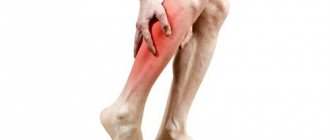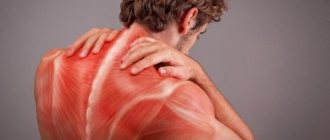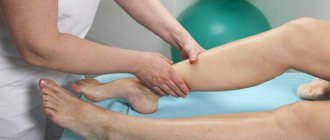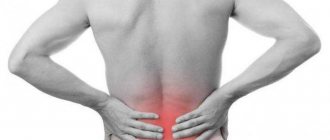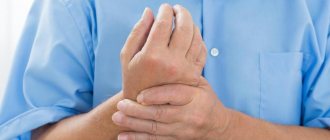Leg cramps and their origins
With calf cramps, involuntary muscle contraction occurs. The main symptoms of muscle spasm include:
- the appearance of aching and pressing pain in the calves;
- repetition of tension every few minutes;
- pain radiating to adjacent parts of the leg;
- inability to move the affected leg.
Muscle contraction during sleep occurs by transmitting nerve impulses from the brain to the limbs. A lack of potassium, magnesium, and calcium in the body affects the occurrence of spasms. When a person sweats during the day in the gym or during heavy physical work, there will not be enough microelements for normal muscle function, since they leave the body along with the fluid.
A similar phenomenon occurs during poisoning, when the body is cleansed of toxins. After all, with them, useful substances that affect the functioning of the smooth muscles of the calves are also lost. This is what causes cramps that get worse at night.
The occurrence of mineral deficiency is also associated with:
- excessive consumption of alcohol, caffeine, nicotine;
- taking certain medications;
- using large amounts of sugar and proteins in the diet;
- low amount of water consumed during the day.
The load on the calf muscle increases in those who wear high-heeled shoes. Spasms occur when the body is overcooled for a long time.
Main causes of night cramps
You need to know why your calves cramp at night in order to eliminate the identified cause of the spasm. Both external factors and pathologies of internal organs affect the condition of muscle tissue.
Failure in the physiology of the body
The fact that you have to spend a lot of time in the gym leads to muscle tissue tension. It cramps your calves when you don’t train for a long time, and then put an unbearable load on the body. After such training you will not fall asleep: you will break everything, twist your legs.
After standing in heels for a long time at work, after parties where you dance a lot, it is difficult for your feet to return to normal. At night you will have to suffer, as the pain will permeate your limbs. Sudden stretching during sleep may also cause contraction of the calf muscles.
Pathological conditions
Among the diseases that cause cramps in the calf muscles at night are:
- atherosclerosis of blood vessels;
- diabetes;
- osteochondrosis;
- brain tumors;
- phlebeurysm.
In people with flat feet, when the arch of the foot changes, it is not uncommon for nighttime cramps to occur. The symptom is especially pronounced when the condition is neglected. Patients with kidney failure use a lot of diuretics. This is one of the reasons for the removal of magnesium and potassium from the body. And these substances prevent the development of cramps in the limbs.
Increased impulsiveness of the brain leads to a malfunction of the nervous system. Hence the appearance of convulsive syndrome. Pathology can be caused by traumatic brain injury, vascular aneurysm, or lack of magnesium in the body.
Diagnostics
Finding out on your own why your legs are cramping does not lead to a positive result. To establish a diagnosis, you should see a doctor. During your appointment, your specialist will find out the following:
- When my legs started to cramp at night.
- What preceded these symptoms?
- Presence of concomitant pathologies.
- Does the patient engage in sports, including physical training?
- Spasms are acute or mild.
- How often he cramps and twists his legs at night.
Cramping legs in pregnant women
Pregnancy is associated with disruptions in the functioning of the body. After a woman’s body removes useful microelements and vitamins, varicose veins develop, the vena cava is compressed, the level of glucose in the blood decreases, blood pressure increases, and the appearance of cramps in the calf muscles is natural.
An unpleasant symptom occurs because a woman’s weight increases and the load on her legs increases. In addition, during pregnancy they rarely do gymnastics and move little, hence the pain in the limbs at night. A routine visit to the doctor can reduce the frequency of the unpleasant symptom. If the spasms are constant, then the pregnant woman needs to be examined.
Why do leg cramps occur?
Some thyroid diseases can lead to seizures.
There are actually many causes of seizures - from banal malnutrition to serious, life-threatening diseases. The vast majority of leg cramps are caused by the causes listed below.
- Imbalance of vitamins and microelements in the body:
- magnesium deficiency is the cause of ¾ of all cases of leg cramps;
- thyroid diseases;
- hypovitaminosis B (mainly B6);
- chronic renal failure (since this disease interferes with the elimination of metabolic products from the body that have a toxic effect on it).
- Reduced blood glucose levels – hypoglycemia. It occurs more often when diabetes treatment is too aggressive or when the diabetic does not comply with the diet.
- Prolonged, excessive physical activity on the legs - running, walking, swimming, football and others.
- Varicose veins, thrombophlebitis.
- Chronic circulatory disorders in the vessels of the lower extremities (obliterating atherosclerosis and other diseases);
- Diseases of the cardiovascular system, accompanied by symptoms of heart failure and, as a result, impaired blood flow in the parts of the body most distant from the heart, in particular in the feet and legs.
- Degenerative-dystrophic diseases of the spine (osteochondrosis).
- Imbalance of female sex hormones, namely, excess estrogen in the blood.
- Psycho-emotional stress.
- Chronic lack of sleep.
Our often incorrect lifestyle leads to the fact that already at a young age, the systems of the human body fail one after another:
- due to constant stress, blood pressure begins to rise,
- Wearing high heels causes problems with veins,
- due to poor nutrition, hypovitaminosis occurs or, even worse, chronic diseases of the digestive tract that disrupt the normal absorption of nutrients from the digestive organs into the blood;
- Due to self-medication of infectious diseases (in particular, tonsillitis), complications develop in the form of steadily progressing heart disease (acquired defects) and kidney disease (glomerulonephritis).
Since the main cause of leg muscle cramps is magnesium deficiency, I would like to highlight this problem in more detail.
The unbalanced diet of most of us leads to the fact that the level of magnesium in the blood gradually decreases. Our bad eating habits, such as regular consumption of coffee, alcoholic beverages, sweet and starchy foods, contribute to less absorption of this microelement from food into the blood. When hypomagnesemia occurs (low levels of magnesium in the blood), the body tries to compensate by “washing out” the trace element from the musculoskeletal system. That is why, if you take a blood test to check the level of magnesium, the results will show the norm or even an excess of this microelement.
In addition to seizures, other symptoms may indicate a lack of magnesium in the body:
- memory impairment, decreased concentration, fatigue, nervous tics;
- numbness of the limbs;
- irritability, anxiety, nightmares, profuse night sweats;
- laryngo-, broncho-, esophageal spasms (periodically occurring spasms of the larynx, bronchi or esophagus);
- abdominal pain, relieved by taking antispasmodics (drotaverine, or no-shpi, spasmobrew, papaverine, platifillin), constipation or diarrhea;
- painful menstruation in women;
- hair loss, brittle nails;
- toothaches, caries;
- pain in the heart area, tachycardia (increased heart rate), various types of arrhythmias.
If a patient, in addition to leg cramps, has several of the symptoms described above, magnesium deficiency should probably be considered one of the causes of involuntary muscle contractions.
In older people
The reason for muscle contraction at night in patients over 60 years of age lies in the changes occurring in the body. Over the course of life, pathologies accumulate, the symptoms of which are pain in the calf muscles. They arise due to:
- damage to nerve endings innervating muscles;
- blood circulation disorders in the lower extremities;
- slow metabolism leading to a lack of B vitamins, potassium, calcium;
- decreased iron levels in the blood;
- degenerative-dystrophic processes in muscle tissue;
- fluid retention in the body.
Inflammations and injuries received in young and middle age “repeat” with paroxysms in old age. In old age, muscle spasms are provoked by medications taken in large quantities: statins, diuretics.
First aid
There are several methods to stop spastic contractions of the limbs:
- Actively massage the cramped leg.
- Gently stretch the muscles of the lower leg or foot.
- Strongly relax tissue.
In some cases, the attack makes itself known in advance. Cramps begin with tension, numbness, pulling pain in the limb, or the legs begin to twist. What to do if you notice these symptoms:
- Rotate your leg, changing its position.
- Achieve relaxation of the muscles of the limb.
- Normalize blood circulation in the feet and legs.
The fastest way to eliminate spasms is muscle stretching. To eliminate night cramps in the lower limb, you need to pull your toes towards you with your hands. In this case, you should try to fully straighten the knee to relax the soft tissues.
If cramps occur frequently at night, you should do the following:
- Sit down or take an upright position with your feet flat on the floor. If possible, take a few steps on a cool surface.
- Gently rub the tense muscle, stroking it, patting it, shaking it.
- Place your leg in an elevated position, for which you should place a pillow under your heels.
Emergency help for tonic leg spasms may include pinching the pulled muscle or a pin prick. These methods instantly relieve cramps both day and night. You can relax the muscle by pinching your leg or biting it. In this case, a reflex switching of activated nerve endings occurs with another stimulus.
Precursors of spasm and first aid
During sleep, they wake up from a cramp in their leg. When you lie down tired and your legs are heavy, then, most likely, a cramp attack will begin at night. Its onset is associated with increasing pain in the center of the calf. By nature it is burning, bursting. Swelling of the veins and swelling below the affected area are noted.
The arteries are compressed by a tense muscle, and the pulsation in them is not visible. You can notice changes in the calves by the pale skin and bluish tint. At the end of the attack, when the capillaries dilate, the leg becomes red.
Is it possible to run in the evening before bed?
You can help yourself by doing the following:
- Pull your foot towards you to stretch the cramped muscle.
- By gently massaging the calf, you can stop the spasm.
- The contracted limb rises upward, above the head.
- Pricking the calf several times with a pin will relieve the pain.
- Apply a cloth moistened with hot water to the affected area. You can add 1-2 drops of lavender or ginger oil to the water.
- Take your leg back, pressing the sole to the floor, the ground. For convenience, you need to rest your hands on the wall.
- Walk around the room, then take a warm bath.
Usually one of the actions stops the convulsive contraction. If there is no result, it is better to call an ambulance.
First aid for calf cramps
If leg cramps are not associated with an epileptic attack, then you need to perform the following simple measures:
- The leg must be elevated to improve blood flow and eliminate existing stagnation.
- You need to grab the toes of the lower limb and bend them towards the knee. First, they are bent halfway and relaxed, and then bent as far as possible and held in this position. This will stop the seizure.
Following these recommendations allows you to stretch the calf muscle, due to which it, like a sponge, absorbs blood saturated with oxygen. Foot massage can improve blood circulation through small blood vessels. Movements should be light and smooth. They come down to pinching and stroking the limb.
Injecting soft tissues with a pencil or other sharp object (without damaging the skin) allows you to interrupt the reflex chain and stop the spasm. This technique is actively used by professional swimmers, who always carry a pin with them. In this way they get rid of the cramp that happened at depth.
After the attack of cramp has been stopped, it is necessary to give an intensive massage to the muscle and stretch it.
To minimize the likelihood of cramping during exercise, your muscles should be warmed up and stretched before you begin. To do this, perform bends with lunges, body bends without lunges, and squats. While bending, exhale and only after that you need to stretch the muscles.
Video: 3 ways to relieve cramps:
What to do if your calf muscle cramps in water?
If a cramp catches a person while swimming in a pond, then under no circumstances should you give in to panic. Whenever there is such an opportunity, you need to loudly call for help. In this case, you must continue to swim towards the shore, actively working with your hands.
The simplest solution is to roll over onto your back. At the same time, you need to breathe deeply and continue to swim towards the shallows using your hands.
If a person is confident in his abilities, then he can relax in the water, taking the form of a starfish. While floating on the water, you need to massage the calf muscle until the cramp goes away. You need to be prepared that in such a position a person will have to plunge headlong into the water from time to time. Therefore, this method can only be put into practice by a swimmer who feels confident at depth and knows how to hold his breath.
So, immediately after a cramp occurs, it is necessary to direct all efforts to eliminate it. After all, this condition is stressful for the body and needs to be eliminated as quickly as possible. Only after this should you search for and treat the cause of calf muscle cramps.
How to treat
Regular paroxysms of the calf muscles can be stopped using pharmaceutical drugs. Traditional healers advise fighting seizures with their proven methods.
Drug treatment
There are a number of medications available to relieve muscle spasms. Their action is aimed at eliminating convulsive symptoms and pain. Tablets of Levetiracetam, Pregabalin, Trental are used after a doctor’s prescription for neurotic conditions.
If paroxysms are associated with a lack of microelements and vitamins, then Asparkam and Panangin are prescribed. To combat vascular disorders, which cause pain in tense muscles at night, you need to take the drugs Troxevasin and Venarus.
Ointments based on horse chestnut stimulate blood circulation and metabolic processes in the affected area. They are applied to the calves before bed, gently rubbing into the skin. It is known what to do if there is a deficiency of vitamins in organisms. The Dolgit and Complivit complexes will restore the conductivity of nerve impulses and prevent muscle spasms.
Physical methods
Among the main methods of relieving muscle tension at night is the effect of magnetic waves on the affected area. The magnetic therapy device normalizes the blood supply to tissues. The cells will receive sufficient nutrition and oxygen, and the convulsions will stop.
Relaxation of muscle tissue occurs under the influence of electric current and ultrasound. Used in cases where the leg is cramped, massage. Done regularly, it will relieve night pain. It is advisable to undergo a course of manual therapy to relieve the effects of frequent leg strain. The calf muscles will recover due to the normalization of blood flow in them.
A professional massage therapist will quickly relieve a seizure attack.
Folk remedies
Treatment with herbal preparations will have a beneficial effect on the condition of the limbs and will not cause side effects:
- Medicinal wormwood 30 grams is poured with boiling water into 400 ml. After infusion and straining, drink a quarter glass 3 times a day. For rubbing, you can use tincture of wormwood in alcohol.
- Take 1 teaspoon of chopped dill fruits, pour 300 ml of hot boiled water. Leave for an hour. Take half a glass or 1 gram of dry fruit powder three times.
- For smooth muscle spasms, mint tablets under the tongue help.
- Tincture of black henbane leaves is useful as an antispasmodic and analgesic. The medicine is prepared from 15 grams of raw materials and 100 ml of vodka. It is better to take 2 drops, diluting them in a tablespoon of water.
- Celandine juice is added to Vaseline and lubricated with the resulting caviar ointment in the evening.
- A pinch of salt is placed on the tongue and held for several minutes. The pain goes away instantly.
- Chamomile flower tea is beneficial for those who suffer from nighttime calf muscle cramps.
Any remedy based on medicinal plants is taken after consultation with a doctor. After all, they may have contraindications.
Mechanism of development of gastrocnemius muscle cramp
To understand the mechanism of development of calf muscle cramps, it is necessary to understand some of the features of its structure. So, this muscle is represented by many myofibrils. Each myofibril is a strip with hundreds of rows of muscle cells. They are called myocytes.
Each muscle cell (myocyte) has a contractile apparatus consisting of several proteins. The main one in them is actin, and the auxiliary ones are troponin, myosin and tropomyosin. Myosin and actin are intertwined with each other like filaments. Their mutual approach, and therefore muscle contraction, occurs under the influence of ATP, calcium ions, troponin and tropomyosin.
This is a multi-level process that goes through several stages:
- An impulse arises in the brain, which is sent along the nerve to the calf muscle.
- With the help of acetylcholine, the electrical impulse from the nerve passes to the surface of the muscle.
- This impulse then spreads throughout the muscle fiber and penetrates its deep structures through T-shaped channels.
- From the channels, the impulse passes to the cisterns (cells containing calcium ions). Calcium channels open and calcium leaves the cells.
- Calcium activates tropin and tropomyosin, which in turn cause actin and myosin filaments to move closer together. ATP takes part in this process.
- Muscle contraction occurs at the moment when the myosin and actin filaments come as close as possible.
If a failure occurs at any stage of this complex process, it will lead to seizures.
Video: neuropathologist on the causes and treatment of seizures during sleep:
Prevention measures
The prevention program includes:
- adherence to daily routine;
- eating greens, especially parsley, fruits, whole grains and dairy products;
- running, swimming;
- leg muscle massage;
- selection of comfortable shoes.
You can train your calf muscles by tensing and relaxing them during exercise and running. In your diet, you should pay attention to salt consumption. Excess and lack of salt leads to health problems.
When your legs cramp at night, it is impossible to sleep. If the attack is fleeting, then it’s not so bad. You can remove it yourself. But sometimes long-lasting painful spasms can be a symptom of a serious illness. And then all that remains is to seek medical help.
